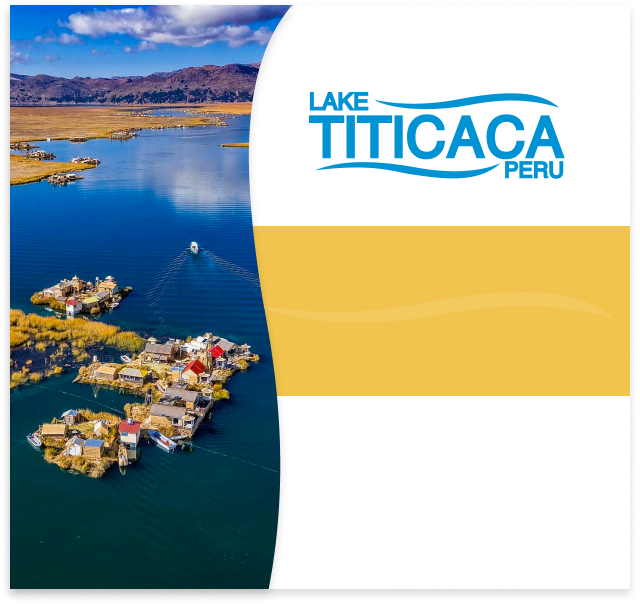Learn more about the
man-made islands at highest
navigable lake in
The World

Lake Titicaca has held an important place in the cosmology of neighboring peoples since prehistoric times. Ancient myth holds that the creator god Viracocha rose up out of its waters to create the sun, moon and stars.
Manco Capac and his sister/wife Mama Oclla, the founders of the Inca Empire and the children of the sun god Inti, are also said to have originated at Lake Titicaca. The empire was born when Inti took pity on the primitive inhabitants of the lake and sent his children, born of the lake foam, to teach and to civilize them.
For these reasons, Lake Titacaca was considered a sacred lake to the Incas and other peoples of the region.
Lake Titicaca is the only significant body of water accessible to landlocked Bolivia, so its importance to that country cannot be overstated. Many residents of La Paz and other cities in Bolivia visit the lake to enjoy beaches, boating and other lake activities.
It’s also the home of a diverse group of native cultures, many of which speak endangered languages, maintain traditional lifestyles and have lived in the area for centuries untold.
Lake Titicaca is a lot of things today: it’s an area for recreation and leisure, a vital border crossing area between Peru and Bolivia, a hub for international tourism, a major historical and cultural zone and much more.
The Uros people of Lake Titicaca live an extraordinarily unique and interesting traditional lifestyle. For centuries, these people have lived their lives on floating islands fashioned from the totora reed which grows abundantly along the edges of the lake. It is believed that the practice began when the Uros people were fleeing from the expanding Inca Empire, but the lifestyle has survived to this day.
Many islands now offer tours or homestays, giving curious visitors a glimpse into their traditional lifestyle. This is a definite must-see for any visitors to Lake Titicaca. Don’t miss the chance to experience this unique culture for yourself.
Isla del Sol (“Island of the Sun”) holds an important place in the mythology and history of the region’s cultures. This sacred island is said to be the place where the creator god Viracocha emerged from Lake Titicaca to create the sun, the moon and the stars. It’s also where the Inca Empire began, according to legend.
Nowadays, Isla Del Sol is considered a highlight of any trip to Lake Titicaca. The island is populated by several different traditional communities and is full of great hiking trails and interesting ancient ruins from the Inca and Tiwanaku cultures.
The beauitiful and peaceful Taquile Island is famed for the detailed traditional textiles of its inhabitants. The main attraction for many visitors, however, are its gorgeous natural and man-made landscapes, with agricultural terraces lining the hills and various ancient ritualistic monuments peppered throughout the countrside.
Visitors to Taquile will cherish the opportunity to experience this traditional culture, as well as take part in some scenic hikes and buy some hand-made textiles, clothing and other souvenirs. The island is very welcoming to tourism, whith a number of restaurants, guides and activities catering to visitors.
The island of Amantaní is home to around 4,000 native Quechua speakers who live a traditional agricultural lifestyle, harvesting the terraced hillsides. The island is also littered with various monuments ard ruins from the Inca and Tihuanaco cultures, left undisturbed since ancient times.
There are no hotels, hostels, b&bs or other tourist accommodation or infrastructure here. That’s why Amantaní island is one of the best places in the region to do a homestay with a local family. There’s no better way to truly experience the traditional way of life on Lake Titicaca.
Known as the Folkloric Capital of Peru for its wealth of traditional music and dance, Puno is an underrated destination for travelers. The city is the site of frequent festivals including the Virgen de la Candelaria festival in February, one of the largest festivals in South America.
Puno is also a convenient hub for reaching nearby attractions on Lake Titicaca such as the Uros Floating Islands or Taquile Island. It’s quite easy to get to Puno, with several different options serving the city. Make sure to check out our Get There page to learn about your transportation options.
Located just 40 km from the center of Puno, Sillustani is the main archaeological attraction of the area. This pre-Inca cemetery consists of a number of imposing tower-like tombs known as chullpas. These elaborate graves were constructed by the Aymara people, for whom ancestor veneration was an important religious tradition.
Not only is the site itself interesting, but the landscape surrounding Sillustani is absolutely gorgeous, with a stunning location overlooking Lake Amayo. Sillustani is easily accessed from Puno and should be considered a must-see for anyone making a visit to the city.
As the main town on Bolivia’s side of Lake Titicaca, Copacabana certainly receives its fair share of visitors. It’s known as a haven for backpackers and vacationing Bolivians as well as an important site of religious pilgrimage. Despite all that, it’s somehow managed to maintain a bit of the charm of a sleepy fishing village.
Copacabana is a great base for excursions on Lake Titicaca, such as the can’t-miss Isla del Sol. Visitors typically arrive to Copacabana by bus. Make sure to check out our Get There page to learn more about your transportation options.
Learn more about the
man-made islands at highest
navigable lake in
The World
